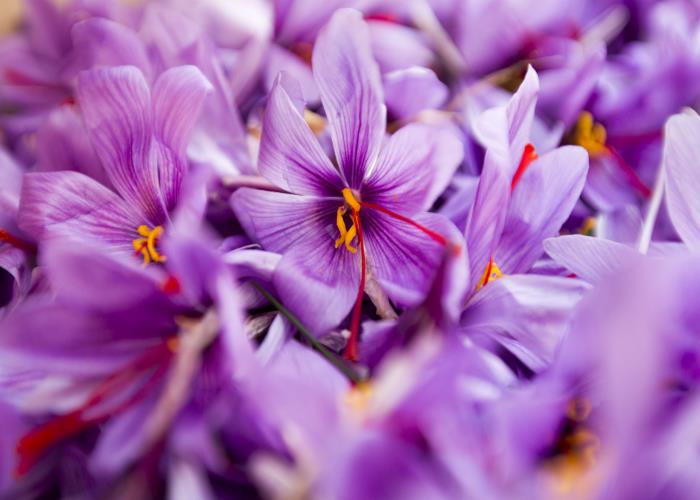The world's most expensive aphrodisiac

Andrew Morgan explains why saffron just got spicier.
It’s already amongst the most expensive and versatile ingredients in the world, used to add colour, flavour and depth to everything from savoury rice dishes like paella to luxurious fish dishes.
But with the revelation by Canadian researchers that saffron is one of only three natural aphrodisiacs in the world, its price and popularity are set to soar.
This is, of course, great news for would be lotharios everywhere! And it should be even better news for Spain, where many experts believe the finest saffron on earth is produced.
While some of the sheen has come off the image of Spanish saffron recently following allegations that the pure (expensive) stuff is being mixed with other, more basic ingredients, the Canadian discovery will undoubtedly still add to the allure – and cost - of saffron.
A natural aphrodisiac
If Professor Massimo Marcone of Guelph University is to be believed, it’s time to forget goji berries, truffles and, I’m afraid, even chocolate: if you really want to spice up your love life naturally it’s time to try saffron.
Professor Marcone admits that claims about the aphrodisiac qualities of certain foods have been around for thousands of years – but he says that only now have their properties been scientifically tested.
He and his team examined hundreds of foodstuffs commonly used as aphrodisiacs, but saffron was one of just three ingredients that positively improved human sexual function.
This scientific rigour should provide all the reassurance needed by anyone feeling the urge to try saffron when they’re feeling a little…ahem… saucy.
It’s going to cost you
Of course many will be put off by saffron’s £6,000 a kilo price tag but the cost is pretty understandable when the sheer effort involved in harvesting the spice is considered.
Saffron gets its dark orange hue from the stigma of crocuses. A whopping 250,000 stigma must be painstakingly separated by hand from the crocus flower to produce a single kilo of pure saffron. All this work must be carried out at dawn to ensure the flower does not lose its colour or pungent aroma.
Saffron growers
Saffron was first cultivated seriously by the troops of Alexander the Great and it’s a fair bet that, with all their pillaging and conquering they appreciated its performance enhancing qualities.
Today saffron prospers in dry, arid landscapes. This means Iran, Kashmir and Morocco all produce top quality varieties of the spice. Saffron that really packs a punch though can be found somewhere a little less exotic.
Spanish saffron
Many believe the finest saffron on earth is to be found growing amid the rocky plains of Castilla La Mancha in Spain.
In a country teeming with Michelin starred chefs, saffron is known as “red gold” and, with the country’s agriculture industry in the doldrums, the expected surge in demand for the spice could not have come at a more opportune time.
During the years of Spain’s economic boom, the back-breaking saffron harvesting didn’t hold much appeal for Castilians.
Less strenuous work could easily be found elsewhere. It’s incredible to think that millions of crocus bulbs lay discarded for years in the dry soil that predominates in this part of the Iberian Peninsula. That all changed when the Spanish economy faltered and now, saffron growers are back in force - really back in force: in 2010 they exported 190,000 kilos of saffron.
That’s a lot of crocuses.
Labelling
Too many crocuses in fact. When figures from the Spanish ministry of industry revealed that in 2010 despite the 190,000 export figure, only 1,500 kilos of saffron had actually been produced in Spain, eyebrows were, quite reasonably, raised.
The authorities conceded that as much as 90% of saffron labelled as Spanish is in fact made up of inferior imports.
Current guidelines actually permit this so long as the saffron is processed and packaged in Spain. Quality inspectors in Spain are also under pressure to get to the bottom of this January’s allegations – by a British amateur cook - that some supposedly top grade Spanish saffron on sale in the UK was being mixed up with other parts of the crocus flower.
In some studies the contamination was as much as 90%. This is currently being investigated by the Food Standards Authority.
Saffron purity
Of course, all of this might make those stocking up on saffron for what might be termed non culinary reasons a bit wary. If you want to make sure that the saffron you buy is going to have what we’ll call the desired effect, there’s loads you can do to check its purity:
1) You can look at the shape of the stalk - in good quality batches it should be trumpet- like.
2) You can also test the saffron stamens in water: real saffron will retain a reddish colour even after 10 minutes soaking, while any stamens that have been manipulated will quickly turn yellow.
3) As ever, reliable sourcing of the product is a good idea. Try a specialist spice shop, or take a look at this handy guide from the people at Brindisa, experts in all things Spanish, who also sell top notch varieties from La Mancha.
And finally...
If saffron’s not your thing, I’m afraid the other ingredients championed by Professor Marcone sound as unappealing and as unseductive as it’s possible for a substance to sound – panax ginseng and yohimbine. This last one comes from the bark of a Nigerian evergreen tree, apparently.
Also worth your attention:
Comments
Be the first to comment
Do you want to comment on this article? You need to be signed in for this feature